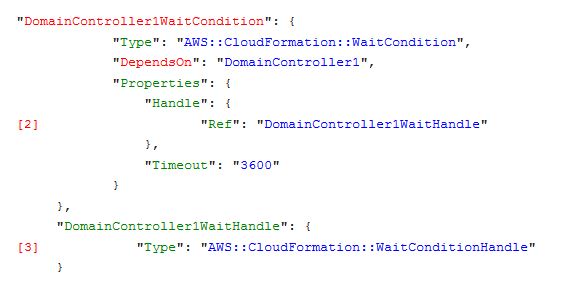Category: government
Ransomware Fightback Takes to the Cloud
Guest post by Raj Samani, EMEA CTO Intel Security (@Raj_Samani)
“How many visitors do you expect to access the No More Ransom Portal?”
This was the simple question asked prior to this law enforcement (Europol’s European Cybercrime Centre, Dutch Police) and private industry (Kaspersky Lab, Intel Security) portal going live, which I didn’t have a clue how to answer. What do YOU think? How many people do you expect to access a website dedicated to fighting ransomware?
If you said 2.6 million visitors in the first 24 hours, then please let me know six numbers you expect to come up in the lottery this weekend (I will spend time until the numbers are drawn to select the interior of my new super yacht). I have been a long-time advocate of cloud technology, and its benefit of rapid scalability came to the rescue when our visitor numbers blew expected numbers out of the water. To be honest, if we had attempted to host this site internally, my capacity estimates would have resulted in the portal crashing within the first hour of operation. That would have been embarrassing and entirely my fault.
Indeed my thoughts on the use of cloud computing technology are well documented in various blogs, my work within the Cloud Security Alliance, and the book I recently co-authored. I have often used the phrase, “Cloud computing in the future will keep our lights on and water clean.” The introduction of Amazon Web Services (AWS) and the AWS Marketplace into the No More Ransom Initiative to host the online portal demonstrates that the old myth, “one should only use the cloud for non-critical services,” needs to be quickly archived into the annals of history.
To ensure such an important site was ready for the large influx of traffic at launch, we had around the clock support out of Australia and the U.S. (thank you, Ben Potter and Nathan Case from AWS!), which meant everything was running as it should and we could handle millions of visitors on our first day. This, in my opinion, is the biggest benefit of the cloud. Beyond scalability, and the benefits of outsourcing the management and the security of the portal to a third party, an added benefit was that my team and I could focus our time on developing tools to decrypt ransomware victims’ systems, conduct technical research, and engage law enforcement to target the infrastructure to make such keys available.
AWS also identified controls to reduce the risk of the site being compromised. With the help of Barracuda, they implemented these controls and regularly test the portal to reduce the likelihood of an issue.
Thank you, AWS and Barracuda, and welcome to the team! This open initiative is intended to provide a non-commercial platform to address a rising issue targeting our digital assets for criminal gain. We’re thrilled that we are now able to take the fight to the cloud.
Acquia, an APN Technology Partner, Leverages AWS to Achieve FedRAMP Compliance
Acquia, a cloud platform for building, managing, and optimizing digital experiences, has received a Federal Risk and Authorization Management Program (FedRAMP) Authority to Operate (ATO), a rigorous cloud security assessment for vendors that sell to the US federal government. The U.S. Department of Treasury sponsored the FedRAMP assessment at the moderate impact level. Acquia’s FedRAMP compliant solutions are powered by the US East and US West AWS regions.
Acquia leveraged the AWS FedRAMP vendor package, inherited the infrastructure controls, and implemented all the other controls at the platform level.
“Leveraging the AWS infrastructure eliminated complexities and management of the policy components throughout the FedRAMP accreditation process. AWS’s security team provided a lot of guidance, not only about FedRAMP, but on Department of Defense security in general,” Peter Durand, VP Federal Sector, Acquia, said, “This partnership with AWS allowed us to cut down the time it took to get our accreditation, gave us ease of assurance and confidence in the security of the infrastructure, and now allows us to continue to provide innovative solutions to our government customers.”
Acquia uses AWS in a variety of ways, such as managing and provisioning the IT infrastructure necessary to host its customers’ websites and web applications. With this FedRAMP certification, Acquia expects to see a significant increase in pipeline as federal government customers can more easily adopt these Acquia solutions.
FedRAMP removes barriers to cloud adoption for government customers. Since websites are a point of entry for agencies into the cloud, this opens the door for federal government customers to look toward the cloud to solve other mission challenges. For Acquia, FedRAMP has accelerated customers move to the cloud, adoption of open source technology, and the use of platform-as-a-service.
When asked about what advice they would give other APN partners looking to receive a FedRAMP ATO, Durand said, “Companies or organizations really need to understand the complexity and investment they need to make to be FedRAMP compliant. And consider a strong sponsoring agency willing to help through the process. As much as it is a lift on AWS, it is also a lot of work on the agency side. Having a federal agency partner who is deeply invested and has the cycles to support the partner going through the process in addition to AWS is helpful.”
AWS partners and prospective customers can also request access to the AWS Partner FedRAMP Security Package by contacting their AWS Sales Account Manager.
Want to continue to learn about FedRAMP? For the fastest path to an ATO, access the AWS NIST Quick Start tools in the AWS GovCloud (US) Console and deploy FedRAMP High-compliant architectures with the click of a button. Learn more and Get Started Now.
Building a Microsoft BackOffice Server Solution on AWS with AWS CloudFormation
An AWS DevOps guest blog post by Bill Jacobi, Senior Solutions Architect, AWS Worldwide Public Sector
Last month, AWS released the AWS Enterprise Accelerator: Microsoft Servers on the AWS Cloud along with a deployment guide and CloudFormation template. This blog post will explain how to deploy complex Windows workloads and how AWS CloudFormation solves the problems related to server dependencies.
This AWS Enterprise Accelerator solution deploys the four most requested Microsoft servers ─ SQL Server, Exchange Server, Lync Server, and SharePoint Server ─ in a highly available multi-AZ architecture on AWS. It includes Active Directory Domain Services as the foundation. By following the steps in the solution, you can take advantage of the email, collaboration, communications, and directory features provided by these servers on the AWS IaaS platform.
There are a number of dependencies between the servers in this solution, including:
- Active Directory
- Internet access
- Dependencies within server clusters, such as needing to create the first server instance before adding additional servers to the cluster.
- Dependencies on AWS infrastructure, such as sharing a common VPC, NAT gateway, Internet gateway, DNS, routes, and so on.
The infrastructure and servers are built in three logical layers. The Master template orchestrates the stack builds with one stack per Microsoft server and manages inter-stack dependencies. Each of the CloudFormation stacks use PowerShell to stand up the Microsoft servers at the OS level. Before it configures the OS, CloudFormation configures the AWS infrastructure required by each Windows server. Together, CloudFormation and PowerShell create a quick, repeatable deployment pattern for the servers. The solution supports 10,000 users. Its modularity at both the infrastructure and application level enables larger user counts.
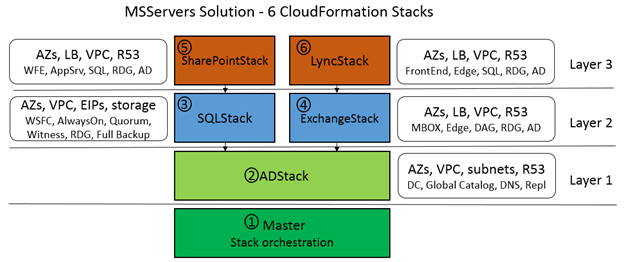
Managing Stack Dependencies
To explain how we enabled the dependencies between the stacks,the SQLStack is dependent on ADStack since SQL Server is dependent on Active Directory and, similarly, SharePointStack is dependent on SQLStack, both as required by Microsoft. Lync is dependendent on Exchange since both servers must extend the AD schema independently. In Master, these server dependencies are coded in CloudFormation as follows:
and
The “DependsOn” statements in the stack definitions forces the order of stack execution to match the diagram. Lower layers are executed and successfully completed before the upper layers. If you do not use “DependsOn”, CloudFormation will execute your stacks in parallel. An example of parallel execution is what happens after ADStack returns SUCCESS. The two higher-level stacks, SQLStack and ExchangeStack, are executed in parallel at the next level (layer 2). SharePoint and Lync are executed in parallel at layer 3. The arrows in the diagram indicate stack dependencies.
Passing Parameters Between Stacks
If you have concerns about how to pass infrastructure parameters between the stack layers, let’s use an example in which we want to pass the same VPCCIDR to all of the stacks in the solution. VPCCIDR is defined as a parameter in Master as follows:
By defining VPCCIDR in Master and soliciting user input for this value, this value is then passed to ADStack by the use of an identically named and typed parameter between Master and the stack being called.
After Master defines VPCCIDR, ADStack can use “Ref”: “VPCCIDR” in any resource (such as the security group, DomainController1SG) that needs the VPC CIDR range of the first domain controller. Instead of passing commonly-named parameters between stacks, another option is to pass outputs from one stack as inputs to the next. For example, if you want to pass VPCID between two stacks, you could accomplish this as follows. Create an output like VPCID in the first stack:
In the second stack, create a parameter with the same name and type:

Managing Dependencies Between Resources Inside a Stack
All of the dependencies so far have been between stacks. Another type of dependency is one between resources within a stack. In the Microsoft servers case, an example of an intra-stack dependency is the need to create the first domain controller, DC1, before creating the second domain controller, DC2.
DC1, like many cluster servers, must be fully created first so that it can replicate common state (domain objects) to DC2. In the case of the Microsoft servers in this solution, all of the servers require that a single server (such as DC1 or Exch1) must be fully created to define the cluster or farm configuration used on subsequent servers.
Here’s another intra-stack dependency example: The Microsoft servers must fully configure the Microsoft software on the Amazon EC2 instances before those instances can be used. So there is a dependency on software completion within the stack after successful creation of the instance, before the rest of stack execution (such as deploying subsequent servers) can continue. These intra-stack dependencies like “software is fully installed” are managed through the use of wait conditions. Wait conditions are resources just like EC2 instances that allow the “DependsOn” attribute mentioned earlier to manage dependencies inside a stack. For example, to pause the creation of DC2 until DC1 is complete, we configured the following “DependsOn” attribute using a wait condition. See (1) in the following diagram:
The WaitCondition (2) depends on a CloudFormation resource called a WaitHandle (3), which receives a SUCCESS or FAILURE signal from the creation of the first domain controller:
SUCCESS is signaled in (4) by cfn-signal.exe –exit-code 0 during the “finalize” step of DC1, which enables CloudFormation to execute DC2 as an EC2 resource via the wait condition.
If the timeout had been reached in step (2), this would have automatically signaled a FAILURE and stopped stack execution of ADStack and the Master stack.
As we have seen in this blog post, you can create both nested stacks and nested dependencies and can pass parameters between stacks by passing standard parameters or by passing outputs. Inside a stack, you can configure resources that are dependent on other resources through the use of wait conditions and the cfn-signal infrastructure. The AWS Enterprise Accelerator solution uses both techniques to deploy multiple Microsoft servers in a single VPC for a Microsoft BackOffice solution on AWS.
In a future blog post on the AWS DevOps Blog, we will illustrate how PowerShell can be used to bootstrap and configure Windows instances with downloaded cmdlets, all integrated into CloudFormation stacks.
This post was originally published on the AWS DevOps Blog. For similar posts and insights for Developers, DevOps Engineers, Sysadmins, and Architects, visit the AWS DevOps Blog. And learn more from Bill in the “Running Microsoft Workloads in the AWS Cloud” Webinar here.
Cloud Transformation Maturity Model: Guidelines to Develop Effective Strategies for Your Cloud Adoption Journey
The Cloud Transformation Maturity Model offers a guideline to help organizations develop an effective strategy for their cloud adoption journey. This model defines characteristics that determine the stage of maturity, transformation activities within each stage that must be completed to move to the next stage, and outcomes that are achieved across four stages of organizational maturity, including project, foundation, migration, and optimization.
Where are you on your journey? Follow the table below to determine what stage you are in:
Advice from All-In Customers
We also want to share advice from our customers across various industries who have decided to go all-in on the AWS Cloud.
“One of the things we’ve learned along the way is the culture change that is needed to bring people along on that cloud journey and really transforming the organization, not only convincing them that the technology is the right way to go, but winning over the hearts and minds of the team to completely change direction.”
— Mike Chapple, Sr. Director for IT Service Delivery, Notre Dame
“For other systems we saw that we could make fast configurations inside Amazon that would make those systems run faster. It was a huge success. And the thing about that type of success is that it breeds more interest in getting that kind of success. So after starting a proof of concept with AWS, we immediately began to expand until fully migrated on AWS”
— Eric Geiger, VP of IT Ops, Federal Home Loan Bank of Chicago
“The greatest thing about AWS for us is that it really scales with the business needs, not only from a capacity perspective, but also from a regional expansion perspective so that we can take our business model, roll it out across the region and eventually across the globe.”
We want to help your organization through your journey. Contact our sales and business development teams at https://aws.amazon.com/contact-us/ or take the “Guide to Cloud Success” training brought to you by the GovLoop Academy.
And also check out the Cloud Transformation Maturity Model whitepaper here to continue to learn more.
California Apps for Ag Hackathon: Solving Agricultural Challenges with IoT
The Apps for Ag Hackathon is an agricultural-focused hackathon designed to solve real-world farming problems through the application of technology. In partnership with the University of California Division of Agriculture and Natural Resources, the US Department of Agriculture (USDA), and the California State Fair, AWS sponsored the Hackathon to find ways to help farmers improve soil health, curb insect infestations and boost water efficiency through Internet of Things (IoT) technologies. The 48-hour event brought together teams from across Northern California, including commercial, federal, state and local, and education organizations.
The goal of the Hackathon was to create sensor-enabled apps to help farmers do things like track water use and fight insect invasions. We provided credits for teams to develop and build their solutions on AWS. Also, Intel provided several Internet of Things (IoT) Kits to help participants build sensor-based solutions on AWS. Additionally, AWS technologists provided onsite architectural guidance and team mentoring.
Check out the winning teams below and the innovative applications built to solve agricultural challenges:
- First Place – GivingGarden, a hyper-local produce sharing app with a big vision.
- Second Place – Sense and Protect, IoT sensors and a mobile task management app to increase farm worker safety and productivity.
- Third Place – ACP STAR SYSTEM, a geo and temporal database and platform for tracking Asian Citrus Psyllid and other invasive pests.
- Fourth Place – Compostable, an app and IoT device that diverts food waste from landfills and turns it into fertilizer and fuel so that it can go back to the farm.
At the Hackathon, we worked closely with many young computer science students and helped them understand the benefits of cloud computing. Experimenting on AWS Lambda allowed the students to deploy serverless applications on AWS quickly. This greatly reduced the time spent focusing on infrastructure and allowed the teams to focus on developing their application. The IoT kits also enabled rapid development and prototyping of solutions. In addition, the teams took advantage of AWS Elastic Beanstalk for rapid delivery of application code.
Working with several states, participants and mentors were able to share information and cross-pollinate ideas, which not only provided value to the development teams at the Hackathon, but will also be valuable to other states in the future.

Learn more about how AWS IoT makes it easy to use AWS services like AWS Lambda, Amazon Kinesis, Amazon S3, Amazon Machine Learning, Amazon DynamoDB, Amazon CloudWatch, AWS CloudTrail, and Amazon Elasticsearch Service with built-in Kibana integration, to build IoT applications that gather, process, analyze, and act on data generated by connected devices, without having to manage infrastructure.
We are hosting an Agriculture Analysis in the Cloud Day with The Ohio State University’s 2016 Farm Science Review. You’re invited to attend the event on September 19th, 2016 from 8:30am – 6:30pm EDT (Breakfast and Lunch are provided), taking place at OSU in the Nationwide & Ohio Farm Bureau 4-H Center. Register now (seats are limited).
Jeff Bezos Joins Defense Secretary Ash Carter’s New Defense Innovation Advisory Board
To continue to enhance the Department of Defense’s (DoD) culture, technology, and processes, Defense Secretary Ash Carter established a Defense Innovation Advisory Board and has asked Amazon Founder and CEO, Jeff Bezos, to join others, including astrophysicist Neil deGrasse Tyson and former Obama administration official Cass Sunstein (see a full list of board members here).
The board, Carter said in his speech, is “charged with keeping DoD imbued with a culture of innovation in people, organizations, operations, and technology, to support people who innovate, those creative figures in our department who are willing to try new things, fail fast, and iterate; and also to ensure that we’re always doing everything we can to stay ahead of potential adversaries.”
In March, Secretary Carter visited the Amazon headquarters and sat down with Jeff Bezos and AWS leadership including Andy Jassy, Charlie Bell, Adam Selipsky, Bob Kimball, Bill Vass, and Teresa Carlson to discuss innovation topics and ways to strengthen military exchange programs and partnerships with the technology industry. The Defense Innovation Advisory Board is another step in the private-public partnership bringing value and best practices to both industry and military.
We appreciate being engaged at the highest levels to help the DoD to innovate. From the Amazon Military Exchange program and DoD Fellowship to the DoD Cloud Computing SRG Impact Level 4 Authorization, we are committed to helping DoD mission owners to continue to leverage AWS for their mission-critical production applications and look for ways we can better help the different branches of the military save money, innovate faster, and deliver capabilities that help achieve their mission.
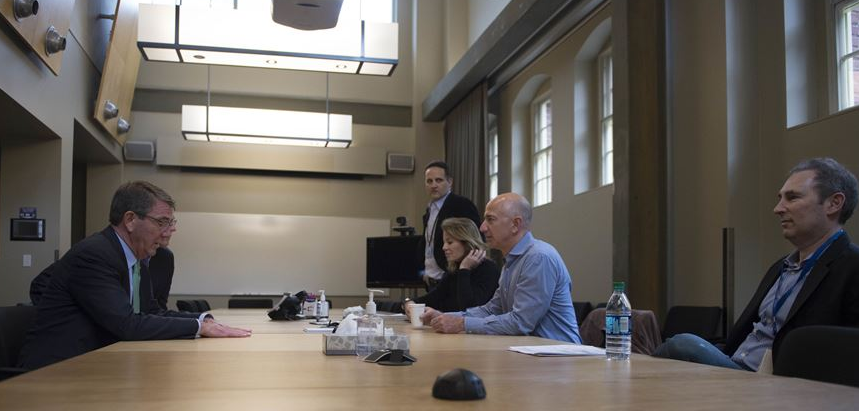
Defense Secretary Ash Carter, left, meets with Amazon CEO and founder Jeff Bezos in Seattle, March 3, 2016. DoD photo by Navy Petty Officer 1st Class Tim D. Godbee
Learn more about how Defense and Intelligence agencies deploy cloud services to reduce costs, drive efficiencies, and successfully achieve their missions.
Exploring the Possibilities of Earth Observation Data
Recently, we have been sharing stories of how customers like Zooniverse and organizations like Sinergise have used the Sentinel-2 data made available via Amazon Simple Storage Service (Amazon S3). From disaster relief to vegetation monitoring to property taxation, this data set allows for organizations to build tools and services with the data that improve citizen’s lives.
We recently connected with Andy Wells from Sterling Geo and looked back at ways the world has changed in the past decade and looked ahead at the possibilities using Earth Observation data.
The world has been using satellite imagery for over 20 years, but the average organization today is just starting to reap the benefits of remote sensing. But from start to finish they need to consider: Where do I get the data from? And what do I do with all of the data?
As a big data use case, it doesn’t get much bigger than this. The physical amount of data captured weekly, daily, and hourly is astronomical and the world keeps spinning. And since the world keeps spinning, it also keeps changing.
“To say there is a tsunami of data is an understatement. And the physical amount of data is only going to go up exponentially. Businesses can get swamped considering: Where do I buy? How do I buy? Why do I buy?” said Andy Wells, Managing Director of SterlingGeo. “But there is an enormous opportunity to evolve governments, educational institutes, and charities by translating that data into something they may need.”
Data is just data unless it is turned into information that can inform better decisions. Without the technology to help make sense of all the data, it never turns into useful information.
Moving from a static model to a dynamic model allows you to keep up with the influx of data coming from satellite imagery and Internet of Things (IoT) technologies. This is a giant leap forward and a big part of what Andy and his team are doing.
Looking at the ‘What Ifs’ – The Art of the Possible
What happens if you could put your analytics engine on the cloud? Instead of an organization investing money up front, running software locally, and training a person without ever seeing value, organizations can turn to the cloud. All of a sudden, you don’t have to invest in the software up front. You just have to run the compute process to turn raw data into information.
“The magic bit of it is that by leveraging the cloud, we can present the result to the end user in a form that is just right for them. It could be in a map or an image in a simple email, taking the heavy lifting off the customer and just providing them with the business information that users need to actually make decisions,” Andy said.
For example, Sentinel-2 data can be analyzed for greenness. The human eye sees in red, green, and blue light, but satellites see in a wider spectrum. So when plants photosynthesize, they put off more near-infrared light, meaning we can actually monitor how healthy plants are, and how much greenery is in a city, and then run an algorithm to see the greenness of an area.
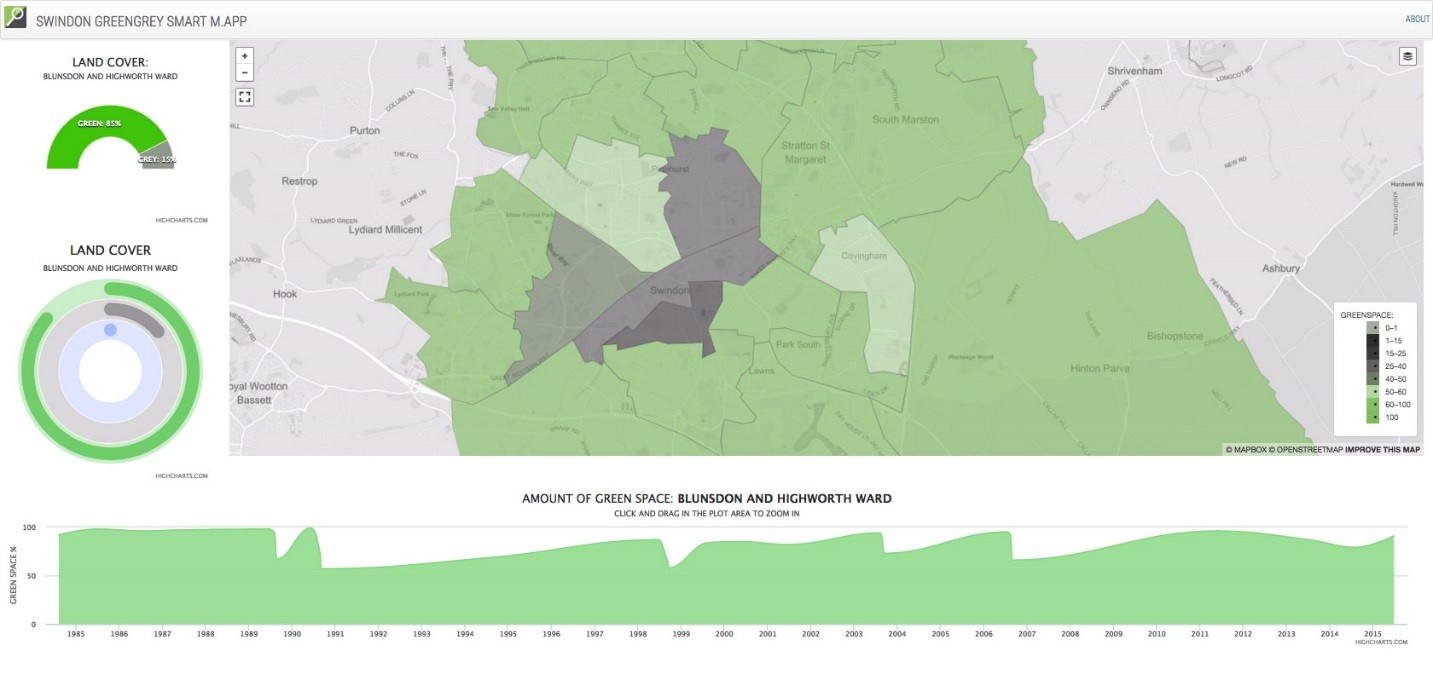

By connecting this algorithm to Sentinel-2 and Landsat data, you can watch how your city has evolved over time in terms greenness, the general heath of a city based on open space, such as parks. Knowing this information allows city leaders to understand if they have paved over too many gardens and parks or where they may need to have more houses or bigger roads. A pilot service of this has now been deployed to numerous local government bodies within a UK Space Agency Programme called Space for Smarter Government.
Being forward-thinking allows companies to solve challenges throughout the world with existing data. The cloud allows them to focus on their mission, without having to worry about where the data is coming from. Leveraging the compute power of AWS gives organizations what they need to make decisions quickly and at a low cost. Andy said, “The good news is, this is not 10 years down the road. These possibilities can be realized today.”
City on a Cloud Innovation Challenge: Partners in Innovation and Cloud Innovation Leadership Award Winners
Last week we highlighted the 2016 City on a Cloud Innovation Challenge Award Winners. We showcased the five winners for the Best Practices Award and the five winners for the Dream Big Award. In addition, Appriss, GRIDSMART, OpenDataSoft, SmartProcure, and Utility, Inc. were this year’s Partners in Innovation Award recipients, recognizing applications that solve local and regional government challenges.
Check out each of the partner winners below:
Appriss – Prior to the introduction of VINE, an automated, reliable method for victims of crime to be notified of offender incarceration status did not exist. With VINE, Appriss systematized and automated the process of providing victims with information regarding offenders, enabling government agency staff to focus on their core responsibilities while allowing those affected to get timely offender information. VINE provides comfort to victims by providing them with critical information regarding their offenders. They can check the status of an offender 24/7/365 and register for automated notifications to provide extra peace of mind that comes with knowing a particular offender is incarcerated. VINE helps keep victims of crime safe and informed.
GRIDSMART – GRIDSMART is an intersection actuation product that actually “sees” the center of the intersection. The GRIDSMART system is made up of a bell shaped camera and connected into a process (GS2) in the traffic cabinet. The system actuates the intersection, provides video feed for situational awareness, and collects and records data on everything happening at the intersection, counts, speed, vehicle classification, and many others.
Utility, Inc – BodyWorn™ is a smart, policy-based, body worn camera solution that allows police departments to set video recording policies with confidence that policies will always be followed reliably and consistently. Video is uploaded automatically and securely to the AWS Cloud. The Amazon-hosted AVaiL Web™ Evidence Management System allows users to categorize, search, and view video evidence, track officers and vehicles, and automatically redact video evidence through a web browser.
OpenDataSoft – OpenDataSoft has built a cloud-based platform for data publishing and API management. OpenDataSoft’s turnkey solution is ideal for cities looking to provide Open Data as a resource for transparency and economic or social innovation. It is designed for non-technical users and makes it easy to publish, visualize, and share any kind of structured data to bring maximum value. OpenDataSoft can also serve as the basis for a Smart City project, as incoming sensor data can be processed in real-time and displayed on visualizations that can easily communicate the data to citizens.
SmartProcure – SmartProcure is a powerful tool used by government agencies to share and access critical purchasing intelligence. Hundreds of millions of government purchase orders from local, state, and federal agencies are made available and easily searchable via SmartProcure. This information is used by agencies to quickly find products, research pricing, verify vendors, ensure compliance, provide data to their citizens, and benchmark their performance internally and externally. This can dramatically reduce costs, increase procurement efficiency, and decrease records requests. SmartProcure uses AWS to make tool available to cities and to government agencies at every level.
This year, we also added a special recognition, the Cloud Innovation Leadership Award, which recognizes an early adopter of cloud technology that has implemented programs and services with a measurable impact on their citizens. The first recipient of the Cloud Innovation Leadership Award is the Singapore Land Authority (SLA) for its OneMap project. OneMap is an integrated map system for government agencies in Singapore to deliver location-based information and services. It functions as a collaborative environment for citizens, private sector, and the community to use open government GIS data to create citizen-facing applications and services.

To learn more about the City on a Cloud Innovation Challenge, visit https://aws.amazon.com/stateandlocal/cityonacloud/.
City on a Cloud Innovation Challenge: Dream Big Award Winners
At our AWS Public Sector Summit in Washington, DC, we announced the winners of the third City on a Cloud Innovation Challenge, a global program to recognize local and regional governments and technology companies that are innovating for the benefit of citizens using the AWS Cloud. In a previous post this week, we highlighted the five winners of the Best Practices category and today we are focusing on the Dream Big Award.
The Dream Big Award recognizes five local and regional governments that have innovative ideas for how they will use AWS cloud technology. The winners of the Dream Big Award will receive credits for AWS services in order to help them implement their ideas. This year’s winners include the City of Boston, Massachusetts; City of Denver, Colorado; Miami-Dade County, Florida; the South Central Planning and Development Commission (SCPD), Louisiana; and Eduserv, based in the United Kingdom.
The winning ideas span several applications of cloud technology, including: analyzing transportation data to better deploy city resources; designing an interactive website to improving citizens’ experience with call centers; and equipping building inspectors with drones to better facilitate the inspection of dangerous locations, like rooftops. Read each description to learn more about each project.
Miami-Dade County – Citizen Relationship Management (CiRM) is an open-source Semantic Web system created to support Miami-Dade County’s 311 Contact Center operations. The system was developed as a platform for case management, GIS and problem reporting modules that improve business processes, promote open data, and enable integration with agency applications. CiRM is innovative in its willingness to challenge traditional government vendor relationships and in its technological design.
City of Boston – The City of Boston is looking to leverage AWS to develop a comprehensive data warehouse and analytics stack to empower research into transportation, crashes, and mobility. Through combining a multitude of data sources, the city will be able to derive more insights and dive deeper into these pressing and salient issues. Through these insights, the city will be able to deploy resources more effectively that will have a positive impact on the citizens of Boston.
City of Denver – Denver’s Smart City Program can be summed up in one simple phrase – connect more with less. With data as the core of a Smart City, a key first step in the approach is to create an Enterprise Data Management (EDM) platform. The EDM platform will allow Denver to use data it already has for its existing operations while serving as the foundation for the expansion of future services. Denver currently collects, manages, and shares data quite effectively. However, the challenge is that many of their systems are constrained by the “silo effect,” which means that any data sharing and analytics across systems must happen manually. The EDM platform will help to remove organizational barriers and conflicts by implementing a structured data delivery strategy – from data producer to data consumer.
Eduserv – Local government organizations are making increasingly large amounts of data available as part of the UK government’s move towards greater transparency. This data often includes details about the current occupancy of council and privately-run car-parks in town and city centers. This project takes that data and uses it to build data-rich websites about the historical use of car-parks, coupled with twitter feeds about current and expected occupancy. Because the data is kept historically, it becomes possible to make increasingly accurate estimates of likely occupancy levels in the future, giving citizens greater ability to plan their journeys into city centers.
South Central Planning and Development Commission – The South Central Planning and Development Commission (SCPDC) is interested in creating a solution that would equip jurisdictional building inspectors with drones to better facilitate the inspection process of locations that place the inspector at risk. These high risk areas include high-pitched rooftops, solar panel installations, and mechanical inspections where HVAC units are placed on rooftops. SCPDC is also studying the possibility of pairing the drone with tablets that run inspection software to integrate and seamlessly link photographs and video into the inspection report. Through the AWS Dream Big award SCPDC has an opportunity to improve the safety and efficiency of many jurisdictional inspectors.

To learn more about the City on a Cloud Innovation Challenge, visit http://aws.amazon.com/stateandlocal/cityonacloud/.
City on a Cloud Innovation Challenge: Best Practices Award Winners
We announced the winners of the third City on a Cloud Innovation Challenge, a global program to recognize local and regional governments as well as technology companies that are innovating for the benefit of citizens using the AWS Cloud, at our AWS Public Sector Summit in Washington, DC. Winners of the four categories, Best Practices, Dream Big, Partners in Innovation, and new special recognition, the Cloud Innovation Leadership, are awarded a total of $550,000 in AWS credits for AWS services.
Five winners were selected for the Best Practices Award, recognizing innovative and impactful local government projects running on the AWS Cloud. To learn more and hear directly from the Best Practices Winners read below.
City of Los Angeles, California – Managing the world’s sixth busiest airport, the largest seaport in the western hemisphere, and infrastructure supporting four million residents, the City of Los Angeles implemented a security information and event management (SIEM) solution for its cyber command center on AWS GovCloud (US) to help consolidate, maintain, and analyze security data across the city’s departments.
“The City of Los Angeles (LA) is the largest target of cyber threats on the West Coast. We have over 100 Million unauthorized attempts against our network every month,” said Ted Ross, CIO, City of LA. “Our ability to gather and synthesize large amounts of cyber threat data is critical to protecting LA and its digital assets. Every day, our security team is loading and analyzing about 240 million records. By leveraging AWS GovCloud (US), we avoid the hardware investment to host and maintain large security logs and gain anytime-anywhere access to the security dashboard for situation awareness and actionable threat information.”
District of Columbia Health Benefit Exchange Authority – DC Health Link is Washington, DC’s health insurance marketplace, which helps residents obtain quality, affordable health coverage. By moving to the AWS Cloud, DC Health Link adopted an agile delivery model, and re-architected the website using open source technology; resulting in a 23 percent increase in enrollment over the prior year, increased website performance, and a cost savings of 30 percent annually.
“The AWS Cloud helps DC Health Link accelerate innovation across our health insurance marketplace, continuously improve our customers’ experience, and scale for growth on demand,” said Suzanne Peck, CIO and General Manager, Health Benefit Services, DC Health Benefit Exchange Authority. “Moving mission-critical IT to the AWS Cloud, combined with adopting open source technology and an agile delivery model significantly helped increase enrollment, dramatically decreased costs, put us on the path to reach our goal of sustainability, and to becoming the first state in the nation where every resident has quality, affordable health coverage.”
Peterborough City Council, United Kingdom – Peterborough City Council uses the AWS Cloud as the central hub for integrating data from weather stations, smart energy meters, connected devices installed in people’s homes, and automated libraries with council’s core applications.
“For Peterborough, we put our citizens and their challenges at the heart of our mission, and to deliver on that mission, we’ve embarked on a journey to be one of the world’s top ‘smart cities,’” said John Harrison, Corporate Director of Resources, Peterborough City Council. “We focus on innovation, skills for the future, open data, and smart businesses, and cloud technology is a key enabler of each of these. We’ve partnered with Arcus Global to design and implement an enterprise-wide platform that is delivering digital transformation across the entire council by breaking down traditional silos, replacing back-end systems and improving visibility across all city services.”
New York Public Library – The New York Public Library’s Digital Collections platform, on the AWS Cloud, makes thousands of its rare and unique research collection items (which cut across applied sciences, fine and decorative arts, history, performing arts, and social sciences) accessible for free to public.
“The AWS Cloud allowed the New York Public Library to build a flexible, scalable, and repeatable computing infrastructure to make over 670,000 digitized items available to the public through our Digital Collections platform,” said Jay Haque, Director of DevOps and Enterprise Computing, New York Public Library. “Our world-class development, product, and DevOps teams were able to engineer robust solutions with full confidence that the technical stack would scale seamlessly on demand. We easily grew our infrastructure to meet a 1500% increase in demand with the highly anticipated release of over 180,000 hi-res public domain images.”
State of Utah – The State of Utah driver license practice exam uses the Amazon Echo and Alexa voice technology to help drivers practice for the exam by reviewing questions, while talking directly with Alexa, the Amazon cloud-based virtual assistant. Hosted on AWS, the voice activated practice exam is a new way for drivers in training to learn the rules of the road.
“Digital assistants present an incredible opportunity for simplifying business operations,” said Mike Hussey, CIO, State of Utah. “Watching how voice technology is spreading rapidly throughout the private sector, we saw a great opportunity to use this innovative technology to help citizens study for their driver’s license. We are always looking for new ways to integrate innovative digital solutions and move beyond how we currently help citizens interact with government.”
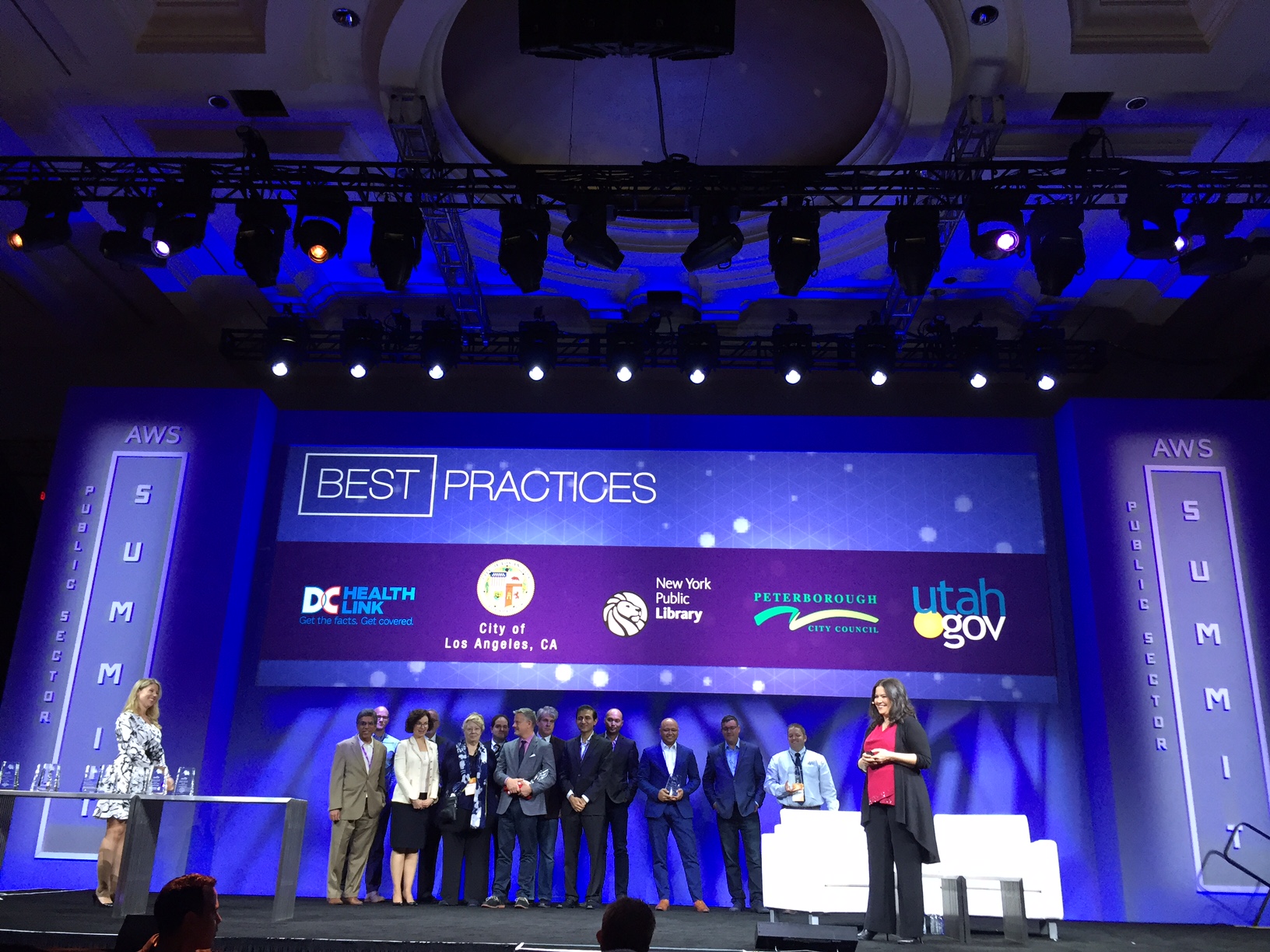
To learn more about the City on a Cloud Innovation Challenge, visit http://aws.amazon.com/stateandlocal/cityonacloud/.







